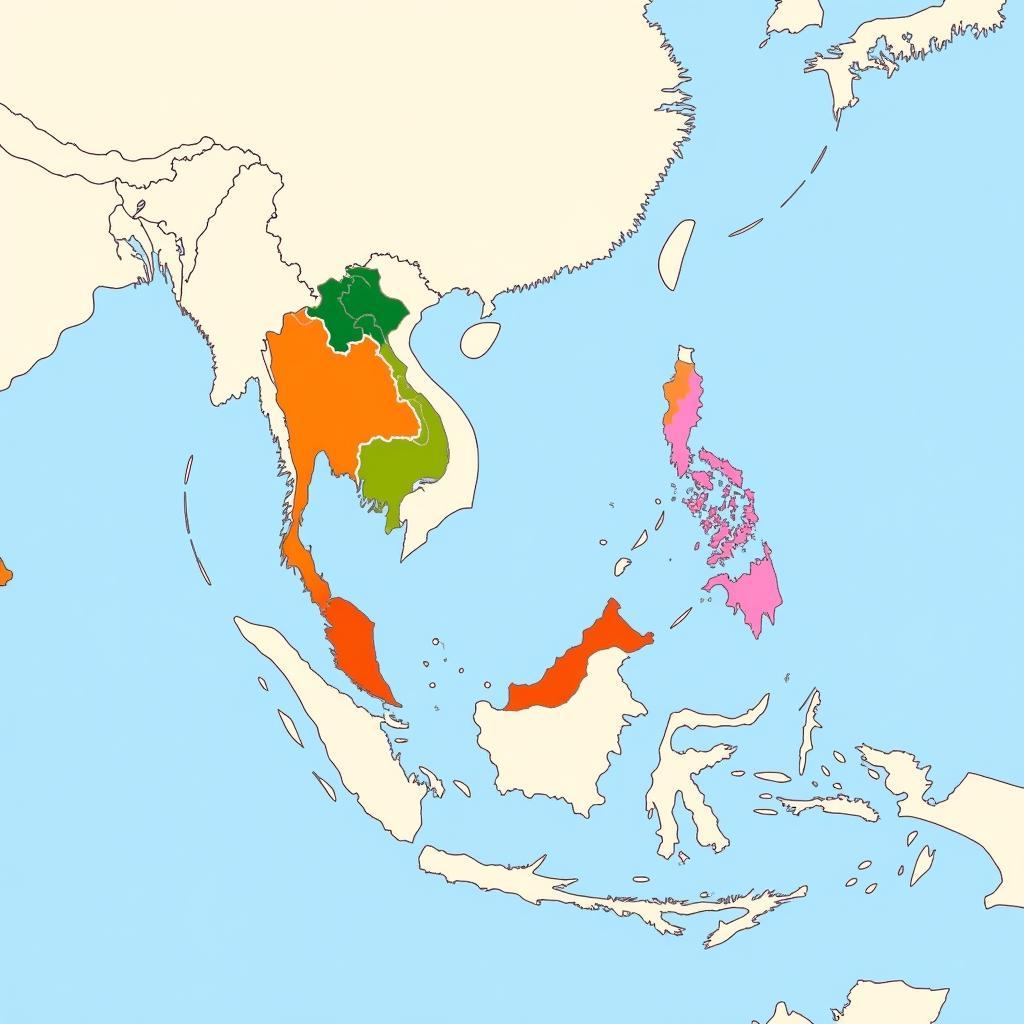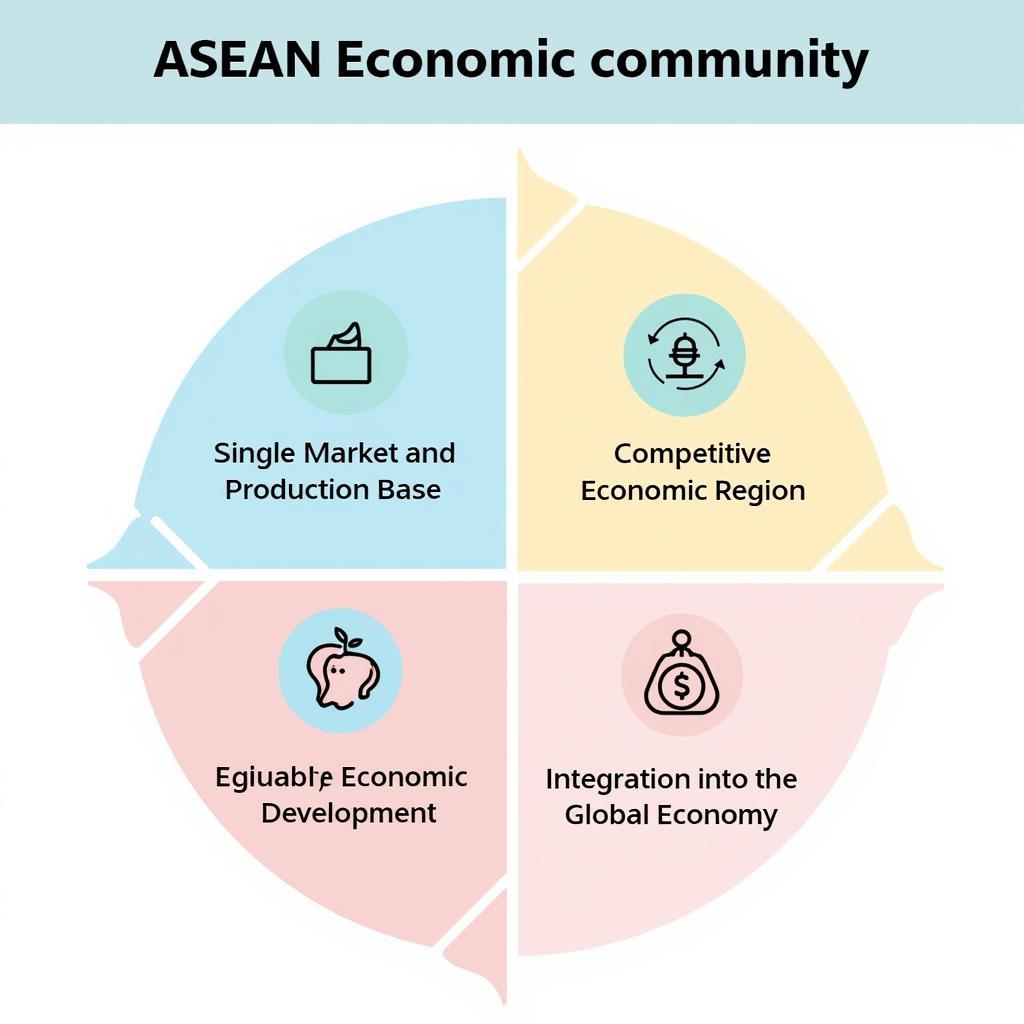The ASEAN Economic Community (AEC) represents a significant step towards regional integration in Southeast Asia. This article delves into the key aspects of the AEC, exploring its potential and examining the challenges it faces in an increasingly interconnected world. We will uncover what “Ase Eure” signifies in the context of the AEC and its implications for businesses and individuals alike.
What is the ASEAN Economic Community (AEC)?
The AEC, established in 2015, aims to create a single market and production base within the ASEAN region. This involves the free flow of goods, services, investments, skilled labor, and freer flow of capital. The goal is to enhance competitiveness, promote greater economic integration, and ultimately improve the lives of the people within the ASEAN community. The AEC blueprint envisions a dynamic and highly competitive region fully integrated into the global economy.
 ASEAN Economic Community Map Showing Member States
ASEAN Economic Community Map Showing Member States
The Four Pillars of the AEC
The AEC is built upon four key pillars, each crucial for achieving its overall objectives:
- Single Market and Production Base: This pillar focuses on creating a free flow of goods, services, investment, and skilled labor. It aims to reduce tariff and non-tariff barriers, harmonize standards, and facilitate cross-border trade.
- Competitive Economic Region: This emphasizes the importance of fair competition, consumer protection, and intellectual property rights. It strives to create a level playing field for businesses operating within the ASEAN region.
- Equitable Economic Development: Recognizing the diverse levels of development within ASEAN, this pillar aims to reduce development gaps and ensure that all member states benefit from economic integration. It focuses on initiatives to support small and medium-sized enterprises (SMEs) and less developed countries.
- Integration into the Global Economy: This pillar emphasizes the importance of ASEAN engaging actively with the global economy. It involves promoting regional trade agreements, attracting foreign direct investment, and participating in international economic forums.
 Pillars of the ASEAN Economic Community: Visual Representation
Pillars of the ASEAN Economic Community: Visual Representation
Challenges and Opportunities for the AEC
While the AEC presents significant opportunities, it also faces several challenges:
- Non-Tariff Barriers: Despite progress in reducing tariffs, non-tariff barriers remain a significant obstacle to trade. These can include complex regulations, differing standards, and bureaucratic procedures.
- Infrastructure Development: Improving infrastructure, including transportation, logistics, and communication networks, is crucial for facilitating trade and investment within the region.
- Skills Development: Developing a skilled workforce is essential for attracting investment and enhancing competitiveness. This requires investment in education and training programs.
- Political and Economic Stability: Maintaining political and economic stability within the region is vital for attracting investment and promoting economic growth.
“Ase Eure” and the Future of the AEC
While “ase eure” isn’t a recognized term within the official AEC framework, it highlights the increasing focus on Europe as a key partner for ASEAN. Strengthening ties with Europe through trade agreements and collaborative initiatives can help ASEAN integrate further into the global economy and diversify its economic partnerships. This could involve exploring opportunities in areas such as sustainable development, digital economy, and innovation.
You can explore further information on related topics at ase limo aspen. This partnership exemplifies the growing collaboration between ASEAN and external partners.
Conclusion
The AEC represents a bold vision for regional economic integration in Southeast Asia. While challenges remain, the potential benefits are immense. By addressing these challenges and fostering greater cooperation, ASEAN can unlock significant economic growth and improve the lives of its citizens. The future of the AEC hinges on continued commitment to its core principles and proactive engagement with global partners. The keyword “ase eure,” though unofficial, highlights the increasing importance of international collaboration for ASEAN’s future.
You may find additional resources helpful, such as information on ase student login, which provides educational opportunities related to ASEAN studies.
FAQ
- What are the main goals of the AEC?
- What are the key challenges facing the AEC?
- How does the AEC benefit businesses in ASEAN?
- What is the role of SMEs in the AEC?
- How does the AEC contribute to regional integration?
- What are the future prospects for the AEC?
- How does the AEC interact with other regional economic blocs?
Need More Information?
For further assistance, please contact us at Phone Number: 0369020373, Email: [email protected] or visit our address: Thon Ngoc Lien, Hiep Hoa, Bac Giang, Vietnam. Our customer service team is available 24/7.


